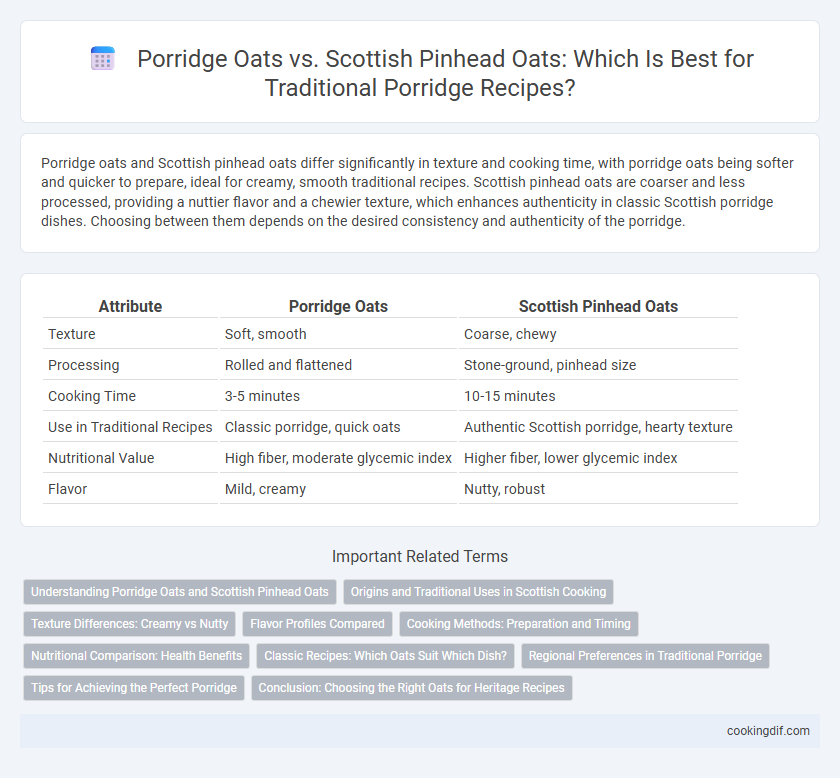Porridge oats and Scottish pinhead oats differ significantly in texture and cooking time, with porridge oats being softer and quicker to prepare, ideal for creamy, smooth traditional recipes. Scottish pinhead oats are coarser and less processed, providing a nuttier flavor and a chewier texture, which enhances authenticity in classic Scottish porridge dishes. Choosing between them depends on the desired consistency and authenticity of the porridge.
Table of Comparison
| Attribute | Porridge Oats | Scottish Pinhead Oats |
|---|---|---|
| Texture | Soft, smooth | Coarse, chewy |
| Processing | Rolled and flattened | Stone-ground, pinhead size |
| Cooking Time | 3-5 minutes | 10-15 minutes |
| Use in Traditional Recipes | Classic porridge, quick oats | Authentic Scottish porridge, hearty texture |
| Nutritional Value | High fiber, moderate glycemic index | Higher fiber, lower glycemic index |
| Flavor | Mild, creamy | Nutty, robust |
Understanding Porridge Oats and Scottish Pinhead Oats
Porridge oats are typically rolled or flaked oats that cook quickly and create a creamy texture, ideal for smooth, comforting bowls of porridge. Scottish pinhead oats, made by stone-grinding whole oat groats into small pieces, have a coarser texture and release more fiber and nutrients, providing a hearty, chewy consistency traditional in Scottish recipes. Choosing between porridge oats and Scottish pinhead oats depends on whether a creamy or textured porridge is preferred, with pinhead oats offering a more authentic and nutrient-rich option for classic Scottish dishes.
Origins and Traditional Uses in Scottish Cooking
Porridge oats, typically rolled or crushed oat groats, originated from general cereal processing methods, whereas Scottish pinhead oats are stone-ground whole oat groats, preserving a coarser texture. In traditional Scottish cooking, pinhead oats are preferred for their hearty, chewy consistency and ability to absorb liquids, making them ideal for authentic porridge and savory oatcakes. The use of pinhead oats reflects Scotland's agrarian heritage and regional milling practices, emphasizing texture and flavor integral to Scottish culinary identity.
Texture Differences: Creamy vs Nutty
Porridge oats yield a smooth, creamy texture ideal for traditional breakfast recipes, absorbing liquid quickly to create a soft consistency. Scottish pinhead oats, coarser and less processed, provide a nuttier flavor and a chewier, heartier texture that holds shape during cooking. Choosing between these oats depends on desired mouthfeel, with porridge oats offering a creamy base and pinhead oats delivering rustic, textured richness.
Flavor Profiles Compared
Porridge oats offer a smooth, creamy texture with a mild, slightly nutty flavor, making them ideal for classic, comforting bowls. Scottish pinhead oats, coarser and stone-ground, provide a heartier, chewier mouthfeel with a more robust, toasted oat taste that enhances traditional recipes. The distinct flavor profiles influence the overall porridge experience, where porridge oats yield a delicate sweetness and Scottish pinhead oats deliver a deeper, more intense oatmeal character.
Cooking Methods: Preparation and Timing
Porridge oats and Scottish pinhead oats differ significantly in cooking methods, with traditional recipes favoring pinhead oats for their coarse texture and longer cooking time, usually around 20 to 30 minutes to achieve a creamy consistency. Porridge oats, being finer and more processed, require less preparation, typically cooking in 3 to 5 minutes, making them ideal for quick meals. Proper soaking and stirring techniques are essential for both to prevent lumps and enhance the overall texture of the porridge.
Nutritional Comparison: Health Benefits
Porridge oats and Scottish pinhead oats differ in texture and nutritional profile, impacting health benefits. Scottish pinhead oats retain the whole groat, providing higher fiber content, which supports digestive health and stable blood sugar levels. Porridge oats, being more processed, offer quicker digestion but slightly lower dietary fiber, making Scottish pinhead oats a superior choice for sustained energy and improved metabolic health in traditional recipes.
Classic Recipes: Which Oats Suit Which Dish?
Porridge oats, finely milled and soft-textured, are ideal for creamy breakfasts and smooth desserts, absorbing liquids quickly for a delicate consistency. Scottish pinhead oats, coarser and minimally processed, retain a toasted nutty flavor and firm bite, making them perfect for hearty traditional dishes like Scotch broth and oatcakes. Choosing between porridge oats and pinhead oats depends on desired texture: smooth and velvety for classic porridge or robust and chewy for authentic Scottish recipes.
Regional Preferences in Traditional Porridge
Scottish pinhead oats, known for retaining more texture and nutty flavor, are preferred in Scotland for traditional porridge recipes, offering a heartier and more rustic dish. In contrast, porridge oats, which are more finely processed, are favored in other regions for a smoother and creamier consistency. Regional preferences reflect culinary traditions, with pinhead oats preserving the authentic Scottish porridge experience and porridge oats catering to broader tastes for softness.
Tips for Achieving the Perfect Porridge
For perfect porridge, choosing between porridge oats and Scottish pinhead oats significantly affects texture and cooking time; porridge oats cook faster and yield a creamy consistency, while Scottish pinhead oats require longer simmering for a nuttier, chewier result. To balance flavor and texture, soak Scottish pinhead oats overnight to reduce cooking time and enhance softness without losing their distinctive bite. Stir continuously during cooking to prevent sticking and achieve a smooth, velvety porridge ideal for traditional Scottish recipes.
Conclusion: Choosing the Right Oats for Heritage Recipes
Scottish pinhead oats retain more texture and release a nuttier flavor, making them ideal for authentic traditional porridge recipes. Porridge oats, typically rolled and softer, cook faster but may lack the distinctive chewiness prized in heritage dishes. Selecting Scottish pinhead oats ensures preservation of traditional texture and taste, honoring the culinary heritage of classic porridge.
porridge oats vs Scottish pinhead oats for traditional recipes Infographic

 cookingdif.com
cookingdif.com